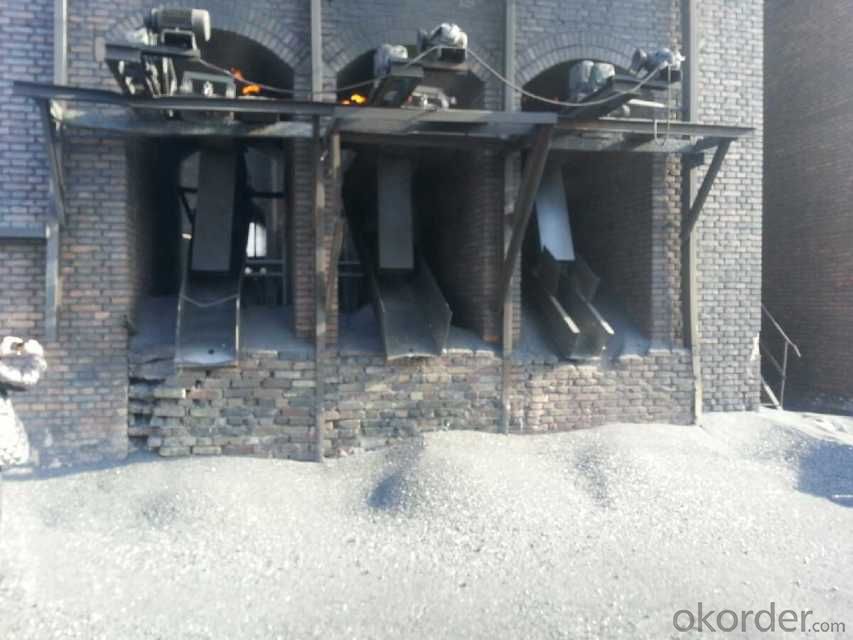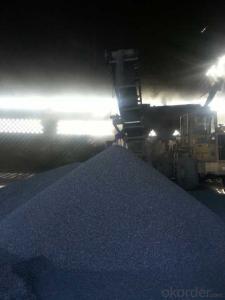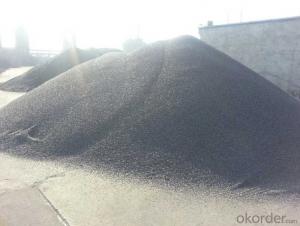Calcined Anthracite FC 80-90 for steel making
- Loading Port:
- Tianjin
- Payment Terms:
- TT OR LC
- Min Order Qty:
- 20 m.t.
- Supply Capability:
- 3000 m.t./month
OKorder Service Pledge
OKorder Financial Service
You Might Also Like
Packaging & Delivery
25kgs/50kgs/1ton per bag or as buyer's request
Specifications
Calcined Anthracite
Fixed carbon: 90%-95%
S: 0.5% max
Size: 0-3. 3-5.3-15 or as request
It used the high quality anthracite as raw materials through high temperature calcined at over 2000 by the DC electric calciner with results in eliminating the moisture and volatile matter from anthracite efficiently, improving the density and the electric conductivity and strengthening the mechanical strength and anti-oxidation. It has good characteristics with low ash, low resistvity, low sulphur, high carbon and high density. It is the best material for high quality carbon products.
Advantage and competitive of caclined anthracite:
1. strong supply capability
2. fast transportation
3. lower and reasonable price for your reference
4.low sulphur, low ash
5.fixed carbon:95% -90%
6..sulphur:lower than 0.3%
General Specification of Calcined Anthracite:
| FC | 80 | 83 | 85 | 88 | 90 |
| ASH | 16 | 14 | 13 | 10 | 8.5 |
| V.M. | 3 | 3 | 2 | 2 | 1.5 |
| S | 0.5 | 0.5 | 0.5 | 0.5 | 0.35 |
| MOISTURE | 2 | 2 | 1 | 1 | 0.5 |
Pictures

We are also strong at below materials, please contact us if you are interested in any of them:
Calcined Petroleum Coke
Carbon Electrode Paste
Carbon Electrode
- Q:The printed document will be marked on the document name: carbon copy, no combination number, two links...... What's the meaning of this? What is the connection between the infinite and the two? I MMM
- [2] (Printing Graphic, Arts printing, also use Graphic Communications graphics communication) is the text, pictures, photos, etc. the application of anti-counterfeiting ink, pressure plate, etc., so that the ink transferred to the surface of paper, textiles, plastic products, leather and other materials, bulk copy the content of technology.
- Q:What's the difference between coal and carbon?
- Coke, too, is quite different from coal in physical properties.
- Q:What is the burning point of carbon?
- There are many forms of carbon, such as charcoal, coal, and even diamonds!And different forms have different ignition points!
- Q:What is the role of carbon in the formation of diamonds?
- The creation of diamonds heavily relies on carbon, as it is the sole element accountable for their existence. Diamonds are generated in the deep recesses of the Earth's mantle, amidst extreme temperature and pressure. When carbon atoms face immense heat and pressure, they undergo a process called graphitization, which entails rearranging their atomic composition and transitioning into a crystal lattice structure, ultimately leading to the formation of diamonds. The process commences with carbon-rich materials, such as organic matter or carbon-bearing minerals, encountering the intense heat and pressure prevalent in the Earth's mantle, generally at depths ranging from 150 to 200 kilometers. In such circumstances, the carbon atoms within these materials are compelled to bond in a distinctive manner, producing the rigid, three-dimensional lattice structure that characterizes diamonds. The formation of diamonds necessitates specific geological conditions, namely temperatures surpassing 900 degrees Celsius and pressures surpassing 725,000 pounds per square inch (50,000 atmospheres). These extreme conditions are typically present in regions where ancient tectonic plates collide or during volcanic eruptions that bring diamonds to the Earth's surface. The ability of carbon to form robust covalent bonds with other carbon atoms is what facilitates the transformation into diamonds. Each carbon atom establishes four sturdy covalent bonds, giving rise to a tetrahedral structure. This formidable bonding empowers diamonds with exceptional hardness, rendering them one of the toughest substances known to humanity. To sum up, carbon plays a vital part in the formation of diamonds, undergoing graphitization amid immense temperature and pressure to create the distinct crystal lattice structure that grants diamonds their extraordinary properties. Without carbon, the creation of diamonds as we presently comprehend them would be unattainable.
- Q:What are the sources of carbon emissions?
- Human activities, particularly the burning of fossil fuels like coal, oil, and natural gas, are the primary cause of carbon emissions. The largest contributor to carbon emissions is the utilization of fossil fuels for generating electricity, transportation, and various industrial processes. Power plants that utilize coal and natural gas play a significant role in emitting carbon, as do vehicles that run on gasoline and diesel. Besides, carbon emissions also result from industrial processes, mainly in sectors like cement production and steel manufacturing. These processes release carbon dioxide (CO2) during the chemical reactions involved in producing these materials. Deforestation and changes in land use are another significant source of carbon emissions. When forests are cleared, the carbon stored in trees is released into the atmosphere as CO2. Moreover, the loss of forests reduces the Earth's capacity to absorb CO2 through photosynthesis, worsening the situation. Agricultural activities, particularly livestock farming, contribute to carbon emissions through the release of methane (CH4) from animals' digestive systems and the decay of organic matter. The use of synthetic fertilizers in agriculture further adds to carbon emissions as they release nitrous oxide (N2O), a potent greenhouse gas. Other sources of carbon emissions include waste management practices, particularly the decomposition of organic waste in landfills, and specific industrial processes that release other greenhouse gases like hydrofluorocarbons (HFCs) and sulfur hexafluoride (SF6). It is crucial to note that although natural processes like volcanic eruptions and wildfires also release carbon dioxide into the atmosphere, their contribution is significantly smaller compared to human-induced emissions.
- Q:What are the health effects of carbon pollution?
- Carbon pollution, specifically in the form of carbon dioxide (CO2) emissions, has a range of health effects on both humans and the environment. The primary health concern associated with carbon pollution is its contribution to climate change. As CO2 is a greenhouse gas, it traps heat in the Earth's atmosphere, leading to global warming and subsequently altering weather patterns. This can result in more frequent and severe heatwaves, hurricanes, and other extreme weather events. These events have direct and indirect health impacts, including heat-related illnesses, injuries, displacement, and the spread of infectious diseases. Furthermore, carbon pollution is closely linked to air pollution, which has significant health consequences. The burning of fossil fuels, such as coal and oil, releases not only CO2 but also a range of toxic air pollutants, including sulfur dioxide, nitrogen oxides, particulate matter, and volatile organic compounds. These pollutants can cause respiratory problems, such as asthma, bronchitis, and other chronic obstructive pulmonary diseases (COPD). Additionally, they can trigger cardiovascular issues and increase the risk of heart attacks and strokes. The health effects of carbon pollution are not limited to the respiratory and cardiovascular systems. Increased temperatures and changes in precipitation patterns can also impact water and food supplies, leading to waterborne diseases, reduced crop yields, malnutrition, and food insecurity. Moreover, the environmental consequences of carbon pollution, such as deforestation and ocean acidification, further exacerbate health risks. Deforestation reduces the availability of clean air and the natural carbon sinks that absorb CO2, while ocean acidification damages marine ecosystems, affecting the availability of fish and other seafood, which are vital sources of nutrition for many communities. To mitigate the health effects of carbon pollution, it is essential to reduce greenhouse gas emissions by transitioning to cleaner and renewable energy sources, implementing energy-efficient practices, and adopting sustainable land-use and agricultural practices. Additionally, investing in healthcare systems and public health infrastructure to address the direct and indirect health impacts of carbon pollution is crucial.
- Q:How is carbon used in the agricultural industry?
- Various purposes in the agricultural industry make carbon widely used. One of its main uses in agriculture is as a soil amendment. The addition of carbon-rich organic matter, like compost or manure, improves soil structure, fertility, and overall health. This occurs because carbon increases the soil's capacity to retain moisture, nutrients, and beneficial microorganisms, all of which are vital for plant growth. In addition to soil amendment, carbon is also utilized in the form of carbon dioxide (CO2) for greenhouse enrichment. In controlled environments such as greenhouses, plants require higher concentrations of CO2 to enhance growth and productivity. Carbon dioxide is introduced into the greenhouse to maintain optimal levels, facilitating photosynthesis and accelerating plant growth. Furthermore, carbon-based fertilizers are commonly employed in agriculture. Fertilizers like urea or ammonium nitrate provide essential nutrients to crops and enhance productivity. Carbon serves as a crucial component in these fertilizers, aiding in the controlled release and effective uptake of nutrients by plants. Moreover, carbon is employed in the production of pesticides and herbicides. Many of these agricultural chemicals contain carbon compounds specifically designed to target and control pests, diseases, and weeds that can harm crops. Carbon-based chemicals are preferred due to their effectiveness and ability to naturally break down without causing long-term harm to the environment. In summary, carbon plays a vital role in the agricultural industry by enhancing soil fertility, promoting plant growth, and aiding in pest control. Its versatility makes it an indispensable resource for sustainable and efficient farming practices.
- Q:How does carbon affect the formation of droughts?
- Carbon does not directly affect the formation of droughts. However, increased carbon dioxide levels resulting from human activities contribute to climate change, which can lead to changes in precipitation patterns and increased likelihood of drought conditions in certain regions.
- Q:How does carbon impact the acidity of rainfall?
- The acidity of rainfall is influenced by carbon, which causes acid rain. Acid rain is formed when carbon dioxide (CO2) is released into the atmosphere and combines with water (H2O) to create carbonic acid (H2CO3). This natural reaction has been significantly amplified by human activities like burning fossil fuels and industrial processes, resulting in increased levels of carbon dioxide in the atmosphere. Once carbonic acid is formed, it can further react with other compounds in the air, such as sulfur dioxide (SO2) and nitrogen oxides (NOx), leading to the formation of stronger acids like sulfuric acid (H2SO4) and nitric acid (HNO3). These acids then dissolve in rainwater and produce acid rain. The presence of carbon in the atmosphere contributes to the overall acidity of rainfall. Acid rain has harmful effects on the environment, ecosystems, and human health. It causes damage to forests, lakes, and rivers, leading to the decline of fish populations and destruction of habitats. Additionally, acid rain corrodes buildings and monuments, erodes metals, and harms crops. The impact of carbon on the acidity of rainfall emphasizes the significance of reducing carbon emissions and addressing climate change. By transitioning to cleaner energy sources, implementing sustainable practices, and reducing our carbon footprint, we can help mitigate the acidity of rainfall and minimize the negative consequences associated with acid rain.
- Q:How are carbon nanotubes used in various applications?
- Carbon nanotubes are used in various applications due to their unique properties. They are used in electronics and semiconductors for their high conductivity, in energy storage devices for their high surface area and lightweight nature, and in medicine for drug delivery and imaging purposes. Additionally, carbon nanotubes find applications in materials science, aerospace engineering, and environmental remediation, among others, showcasing their versatility and potential impact across multiple fields.
1. Manufacturer Overview |
|
|---|---|
| Location | |
| Year Established | |
| Annual Output Value | |
| Main Markets | |
| Company Certifications | |
2. Manufacturer Certificates |
|
|---|---|
| a) Certification Name | |
| Range | |
| Reference | |
| Validity Period | |
3. Manufacturer Capability |
|
|---|---|
| a)Trade Capacity | |
| Nearest Port | |
| Export Percentage | |
| No.of Employees in Trade Department | |
| Language Spoken: | |
| b)Factory Information | |
| Factory Size: | |
| No. of Production Lines | |
| Contract Manufacturing | |
| Product Price Range | |
Send your message to us
Calcined Anthracite FC 80-90 for steel making
- Loading Port:
- Tianjin
- Payment Terms:
- TT OR LC
- Min Order Qty:
- 20 m.t.
- Supply Capability:
- 3000 m.t./month
OKorder Service Pledge
OKorder Financial Service
Similar products
New products
Hot products




























